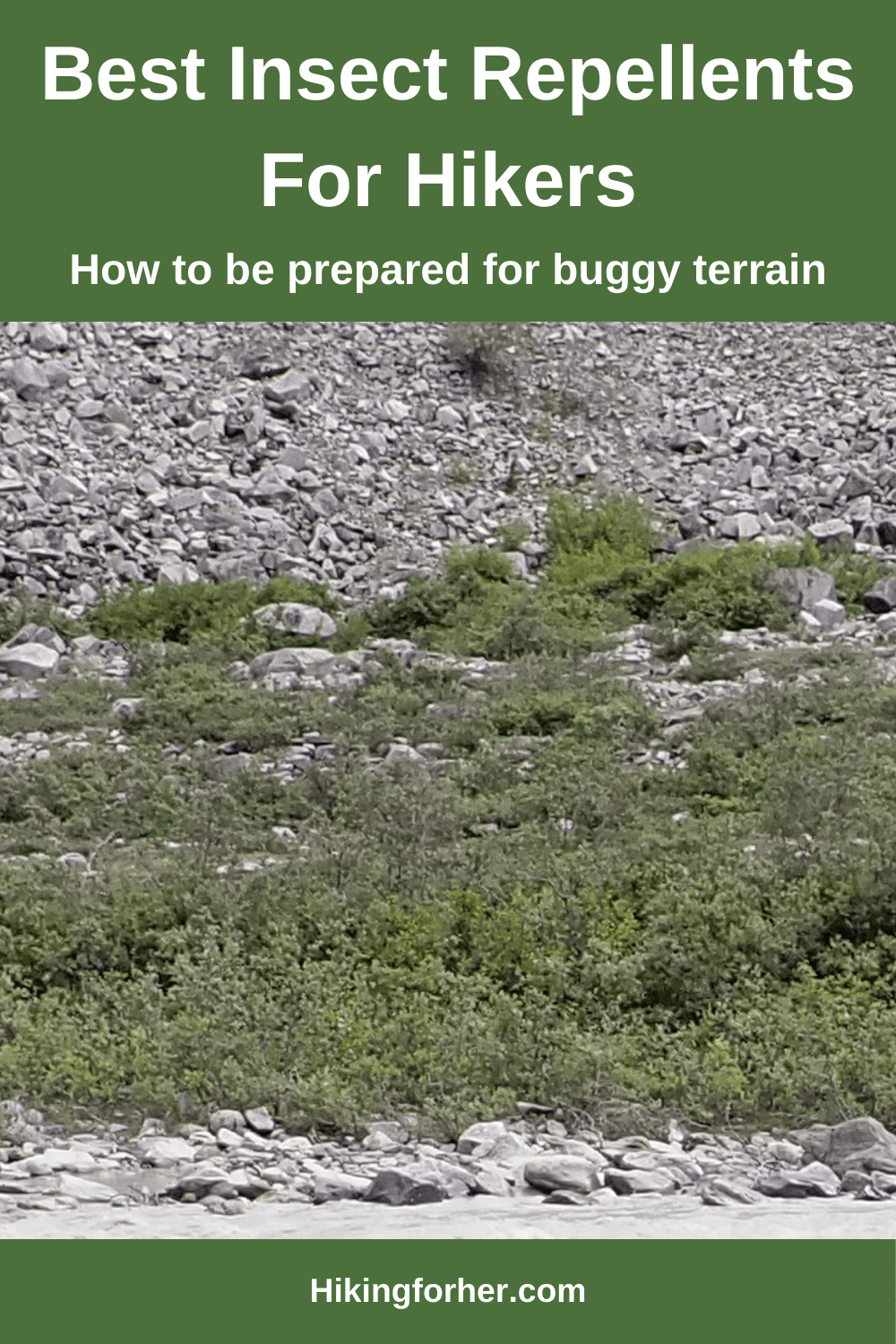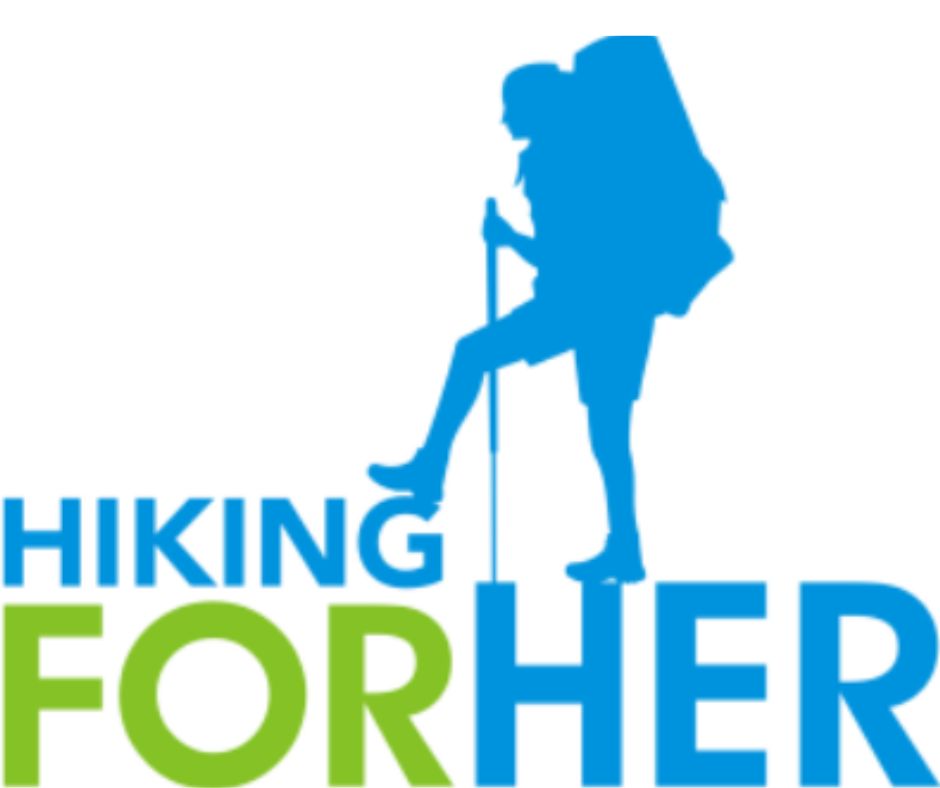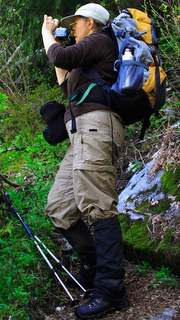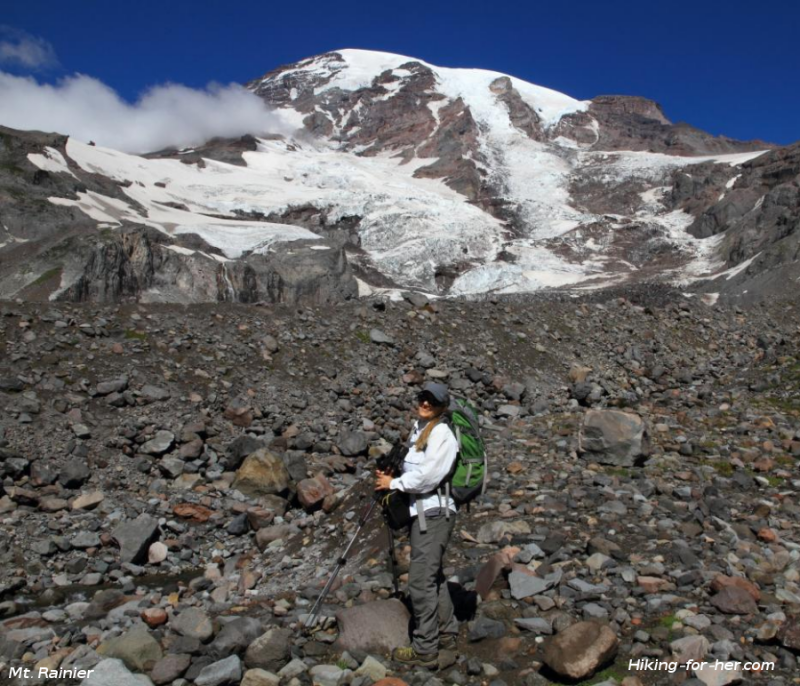Enjoy Happy Trails, the free monthly newsletter from Hiking For Her
Receive a free resource: "Hiking Layering System Explained"
Best Insect Repellents:
Top Choices For Hikers
By Diane Spicer
Sad as it is for a nature loving hiker to admit, insect repellents are an important part of hiking techniques.
And why do we, sturdy and resolute hikers, want to repel insects?
Seriously, aren't we in the outdoors to soak up the full Nature experience?
The answer depends upon the hiker you're asking.
For quick solutions, drop down here:
Do insects creep you out?
Some hikers are deathly afraid of bees and other stinging or biting insects.
- Allergies, pain, or simply not understanding what the insect is doing as it buzzes around can lead to phobias.
Other folks go all weird when they find a wood tick crawling on their pants leg.
- Ewww!! A creepy crawly ON MY LEG.
Silly? Sure, maybe you're unfazed by insects on your body.
But wait just a minute.
What about your trail buddies?
If you're hiking with a person who has insect phobias, it can lead to an unpleasant trail experience when that person transforms into a wailing, flailing freak out right in front of your eyes.
Trail tip:
It's probably a good idea to ask your hiking partners about insect issues, if you haven't already.
- That way you won't be caught off guard (or wounded accidentally) by a flying hiking pole!
Worried about getting sick
from biting insects?
Another reason for using insect repellents while hiking is to minimize exposure to disease.
There are certain insects (mosquitoes) and other small biting trouble makers (ticks) which act as vectors, transferring diseases in their saliva once they bite a human.
Examples of these diseases in the United States include Lyme (Borreliosis) disease, Rocky Mountain Spotted Fever, West Nile fever, and encephalitis.
The mosquito borne Zika virus is working its way northward into the United States, too.
And because hikers are exposed to these insects at higher rates than people who don't venture outdoors, it makes sense to have an insect repelling plan.
Skip the itch!
Yet another reason to repel insects: insect bites hurt and itch.
If you scratch them with your dirty nails (unavoidable on the trail), you can set yourself up for a secondary bacterial skin infection.
Try this "after bite" product to minimize the discomfort. I've had good success with it.
- Stash some in your backpack and your first aid kit, to be sure you're covered.
And carry some pre moistened wipes like these to cleanse any bites before you apply the product.
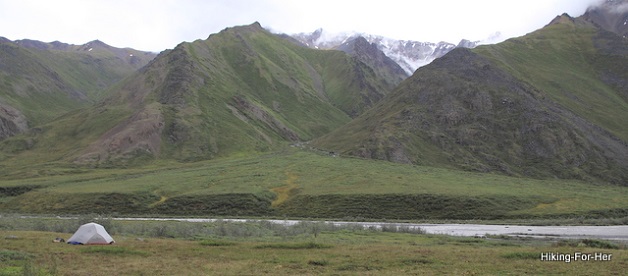 Perfect terrain for using insect repellents! ANWR, Alaska, USA
Perfect terrain for using insect repellents! ANWR, Alaska, USA
Effective insect repellents
So what should you rely on to repel insects?
You have some choices, and you need to be clear about the pros and cons of each choice.
All insect repellents are NOT alike.
DEET
The first choice of insect repellents a hiker can make: widely available, inexpensive and potent chemicals.
Here's a fact sheet on DEET, the classic example of a heavy duty manufactured insect repellent.
It was developed by the U.S. military, and is now widely available in various strengths.
- Here's what I carry when I want to get serious about repelling insects.
It can be applied to skin, or to clothing, or both.
Why does it work?
Insects can't stand the way it tastes!
Which is the first clue that it might be toxic.
- And in fact, it inhibits a key enzyme in mammalian central nervous systems.
So be cautious with your applications of this chemical, using it in small amounts only when you absolutely have to.
And avoid using it on very young kids whose nervous systems are still developing.
Permethrin
Another chemical name you may have seen: permethrin.
It's used to kill ticks and repel insects.
This is a heavy duty chemical, toxic to cats and fish, but not dogs (good to know if your hiking dog licks your hand).
Use it carefully on your clothing and hiking gear, and be aware that it is considered a carcinogen.
Here's a brand hikers and campers both can use.
Use in small doses, only when needed
I've used these chemicals insect repellents in Alaska, Greenland and the Canadian Rockies: hot spots for insects!
But sparingly, every so sparingly... which means wait a bit and see if the insects go away due to a breeze or bright sunshine.
Natural repellents
To avoid toxicities, you might be interested in natural insect repellents.
I've had good success with this herbal brand called Natrapel in buggy terrain, although it's quite odorific.
Store the bottle double wrapped, in your bear canister.
- Don't bring it into your tent for any reason!
- Wash up before bedtime with soap or pre-moistened towelettes like these.
Know about Neem oil?
Or you could give something a little different, a try!
I carry a small amount of this Neem oil with me, to use not only to avoid bites but to take away the swelling and itchiness afterwards (if I forget to apply it before setting off on a hike).
So what is Neem?
It's a vegetable oil made from an evergreen tree which grows in India.
- It's not meant to be ingested, but applied to the skin.
- It has a unique odor, which I find hard to describe. Not unpleasant, but definitely noticeable. Not suitable inside a tent in bear country!
- It doesn't work 100% of the time, but it's effective enough that I can avoid chemical exposures in some situations.
And you can use it to soothe and moisturize your dry skin and cuticles on a backpacking trip.
One more essential choice to go natural
One more option: Use a blend of aromatic essential oils, including cedar, thyme, rosemary and garlic.
Here's a company that can get you started.
Unless all of those flavorful odors on your skin will make you hungry ;)
And be careful in bear country with these oils.
Newest anti-bug portable technology
How about a portable insect repeller, a device that keeps the bugs awat?
Thermacell has a wide range of options for your back yard, your day hike, and even your backpacking trip.
You don't have to spray anything on your skin.
And the repellent is based on natural plant sources.
Take a look at their backpacker mosquito repellent for an easy solution to buggy campsites.
- Easy to transport and use.

They also offer a rugged portable repeller suitable for day hikes in buggy areas:

A non-chemical low tech choice:
wear bug nets
In extremely buggy areas, bug nets that you wear are a life saver.
Here's why you should consider a head bug net with a recommendation for a brand that I use myself.
Or consider a complete upper body coverage bug net like this one.
Dorky looking?
Why, yes, but you won't be scratching your bites all night long, either.
Ready to be repellent?
It's a mistake to go into boggy, wet trail conditions or set foot on spring hiking trails thinking that you can just grit your teeth and bear it.
- More likely, bare it.
You might be able to endure the physical discomfort of dozens upon dozens of insect bites on exposed skin, but don't overlook your mental comfort.
The buzzing, whining and stinging will get to you after awhile.
Or the sight of a crawling tick could unnerve even the most rugged hiker.
Why not have an insect repelling plan?
- It's an addition to the hiking Ten Essentials that makes good sense for trail comfort.
And now you know how to put a good plan together!
Home page > Best Hiking Gear >
Insect Repellents

